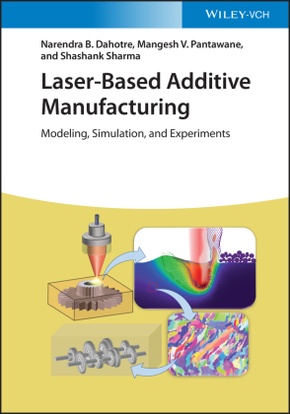Laser-Based Additive Manufacturing - Modeling, Simulation and Experiments
| Verlag | Wiley-VCH |
| Auflage | 2022 |
| Seiten | 304 |
| Format | 17,6 x 1,9 x 25,5 cm |
| Gewicht | 728 g |
| Artikeltyp | Englisches Buch |
| ISBN-10 | 3527347917 |
| EAN | 9783527347919 |
| Bestell-Nr | 52734791A |
The book provides a framework for understanding materials processing during laser-based additive manufacturing by computational modeling and simulations. It thereby enables the users of this technique to improve the compositional, phase and microstructural evolution within the material and the subsequent mechanical, chemical, and functional properties of the manufactured components.
Inhaltsverzeichnis:
1 INTRODUCTION TO ADDITIVE MANUFACTURING
1.1 Manufacturing Techniques
1.2 What is Additive Manufacturing (AM)?
1.3 Laser-based Additive Manufacturing (LAM)?
1.4 Advantages of AM over Conventional Manufacturing
1.5 Current Challenges Associated with AM
1.6 Importance of Computational Modeling in AM
1.7 References
2 COMPUTATIONAL MATERIALS SCIENCE
2.1 Introduction to Computational Materials Science
2.2 Length- and Time-Scale in Materials Modeling
2.3 Current State of Computational Modeling in LAM
2.4 References
3 LASER-MATERIAL INTERACTION IN LAM
3.1 Conversion of Light Energy to Heat
3.2 Modes of Heat Dissipation
3.3 Dynamics of the Melt-Pool
3.4 References
4 MICROSTRUCTURAL AND MECHANICAL ASPECTS IN LAM INTEGRATED WITH MODELING
4.1 Solidification
4.2 Microstructural Variation and its Prediction
4.3 Effects of Laser Parameters
4.4 Scanning Strategy and Texture Evolution in the Microstructure
4.5 Mec hanical Properties
5 RESIDUAL STRESSES AND THREE-DIMENSIONAL DEFECTS IN LAM
5.1 Design of Precursors in LAM
5.2 Thermal Stress Modeling
5.3 Optimum Laser Parameters and Scanning Strategy Prediction by Modeling
5.4 References
6 SURFACE PHYSICAL TEXTURE IN LAM
6.1 Effect of Melt-Pool Dynamics on Surface Texture
6.2 Surface Physical Texture Variation in LAM
6.3 References

